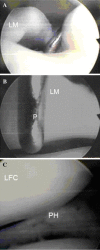The discoid meniscus
- PMID: 19308479
- PMCID: PMC2656711
- DOI: 10.1007/s11832-007-0029-1
The discoid meniscus
Abstract
Discoid lateral meniscus is an intra-articular knee disorder typically presented in the young population and during adolescence. Different types of meniscal disorders and varied forms of presentation have been reported. The natural history depends on the type of anomaly and the presence of symptoms. Management of the disorder should be directed toward the resolution of the symptoms while preserving meniscal tissue and function. Modern surgical techniques enable suturing and preservation of meniscal tissue. The clinical manifestations, diagnostic modalities and criteria, accompanying conditions and practical management considerations are reviewed.
Figures



References
-
- Young R. The external semilunar cartilage as a complete disc. In: Cleland J, Mackay J, Young R, editors. Memoirs and memoranda in anatomy. London: Williams and Norgate; 1889. p. 179.
-
- Andrish J. Meniscal injuries in children and adolescents: diagnosis and management. J Am Acad Orthop Surg. 1996;4:231–237. - PubMed
-
- Kaplan EB. Discoid lateral meniscus of the knee joint. Bull Hosp Joint Dis. 1955;16:111–124. - PubMed
-
- Clark C, Ogden J. Development of the menisci of the human joint: morphologic changes and their potential role in childhood meniscal injury. J Bone Joint Surg Am. 1983;65:538–547. - PubMed
LinkOut - more resources
Full Text Sources

